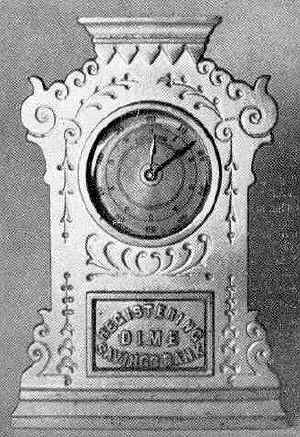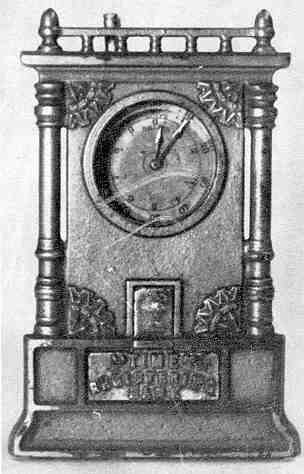Two Clock Type Banks
by F.H. Griffith - HOBBIES Magazine - March, 1974
 Mechanical banks that were made to look like watches or clocks are
rather few and far between. In the more than 20 years that these articles have been
written only two watch mechanicals have appeared, along with one clock type. The clock
bank covered is a very rare item and actually utilizes a regular working clock.
Mechanical banks that were made to look like watches or clocks are
rather few and far between. In the more than 20 years that these articles have been
written only two watch mechanicals have appeared, along with one clock type. The clock
bank covered is a very rare item and actually utilizes a regular working clock.
This is the Time Lock Savings Bank, HOBBIES, September 1969. The Time is Money Bank (HOBBIES, May 1959) could be a fringe bank in the clock and watch category, but it does not actually represent nor is it in the form of either one. So to get to the point we now come to the unusual circumstances of classifying two clock type mechanical banks, the Registering Dime Savings Bank, No. 232 in the numerical classification, and the "Time" Registering Bank, No. 233. Let us make one thing clear right now, these are mechanical banks, not just registering banks. True the word "registering" appears in the name of each bank, but as with the Perfection Registering Bank (HOBBIES, September 1959) there is a lot more to each bank than simply having the amount registered. Also true, however, is the fact that each bank could be included in a collection of registering banks if one so chooses.
The Registering Dime Savings Bank, Figure 1, has the configuration of an 1890-1910 period oak case mantle or shelf clock. It is a well made nickel plated cast iron casting with nice detail. The clock face is paper and the hands are the same as those used on a regular clock. A beveled glass protects the face and hands. The name Registering Dime Savings Bank appears on the door as shown in the photo.
The 1891 Premium Supplement for the Ladies Home Journal has an excellent picture of the bank and well describes it as follows:
A REGISTERING SAVINGS BANK
Given as a Premium for a Club of 5 Yearly Subscribers at $1.00 each; or, for 4 Subscribers and 25 cents extra; or, for 3 Subscribers and 50 cents extra. Price, $1.50. Sent by Express, charges to be paid by the receiver.
This Bank indicates, at all times, the exact amount contained. A coin cannot be deposited without being accurately registered. The first coin locks the door, which cannot be locked in any other manner, nor can it be again opened until full amount for which the Bank is set has been deposited — then — it opens automatically — and no money can be removed until the door has unlocked itself!
This is one of the few Savings Banks which successfully defy ingenuity, and which refuses to be opened. No money can be extracted by anyone, until the full amount has been deposited, and no one can tamper with it without being detected by the figures. These banks are sold by the Fire-proof Safe Companies. Strongly made of cast iron, handsomely nickel plated. Packed in a strong wooden box.
Price $1.50. Sent by Express, charges to be paid by the receiver.
 Adding to this description, the
minute hand moves automatically with each dime deposited. Ten dimes are necessary to
complete the circle of the dial by the minute hand. When this is done the hour hand moves
to the figure 1 indicating $1.00 in the bank. After the deposit of $10.00 the door front
with the name thereon automatically drops forward. Only dimes can be used in the bank and
the weight of each coin causes the action.
Adding to this description, the
minute hand moves automatically with each dime deposited. Ten dimes are necessary to
complete the circle of the dial by the minute hand. When this is done the hour hand moves
to the figure 1 indicating $1.00 in the bank. After the deposit of $10.00 the door front
with the name thereon automatically drops forward. Only dimes can be used in the bank and
the weight of each coin causes the action.
The "Time" Registering Bank, Figure 2, is somewhat larger than the Dime Registering Bank as described above, and while different in configuration it too represents an oak mantle or shelf clock of the same period. It too is a nickel plated finely detailed cast iron casting with paper dial, regular clock hands, and beveled glass. Fortunately the original paper label is intact on the back of this bank. We quote from this label as follows:
Time Lock Registering Bank For Dimes
The Bank cannot be locked unless both hands point to 0.
To lock the Bank place the door in position and press it firmly. Place a dime in the chute and pull the chute quickly right, then to the left and the dime will then be deposited, the door locked, and the amount registered on the dial.
When 100 dimes ($10.00) are deposited, the bank will unlock and the door drop out. The long hand registers cents, the short hand registers dollars. When one hundred dimes are deposited and both hands point to 0 the Bank unlocks.
Patent Applied For
I.B. & W. Co.
The back section on which the paper label appears is finished in a heavy black enamel. The time period of the bank is approximately the same as that of the Registering Dime Savings Bank. Please note it is necessary to move the chute right and left to cause the action on the "Time" Registering Bank. The weight of the dime does not automatically move the hands as with the Registering Dime Savings Bank. Otherwise the operations of each bank are the same.
These two clock type banks make quite interesting additions to a collection of mechanicals. They have a rather different attractive appearance and are very difficult to find in the fine all original condition as the one pictured in Figure 1. The bank described in Figure 2 is not the one pictured. That is to say the bank pictured was in the writer’s collection but he recently upgraded it with the described one having the original paper label and in excellent all original condition.
